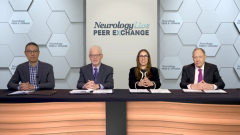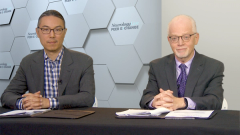
Recent Approvals for NMOSD Treatment
Experts in neurology discuss newly approved medications in the treatment of neuromyelitis optica spectrum disorder, including inebilizumab, eculizumab, and satralizumab.
Episodes in this series

Brian Weinshenker, MD: Let’s concentrate, Bob, on the new FDA-approved treatments. Can you tell us a bit about how they work?
Robert Shin, MD, FAAN: Well, we have 3 different options currently. And the first approved treatment that Dr Miller’s been practicing pronouncing is eculizumab, which targets complement, so it binds to C5 [cervical nerve 5] and the complement cascade prevents the cleavage of C5 to prevent the destructive effects of complement on the astrocytes.
The next treatment that was approved was inebilizumab, which has a different target. By the way, these are all monoclonal antibodies, but this antibody targets CD19. This is a marker that’s expressed on B cells. Many people may be familiar with the anti-CD20 strategy in multiple sclerosis [MS]. The marker CD20 is expressed on a subset of B cells, but CD19 is expressed on a slightly broader set of those cells, which includes, for instance, plasmablasts and to some degree plasma cells that might be involved in antibody production.
The third option that we currently have is certolizumab, which targets interleukin-6, IL-6, which is a pro-inflammatory type of cytokine and presumably acts by mitigating those pro-inflammatory effects. So, there’s 3 highly effective therapies with quite different mechanisms of action.
Flavia Nelson, MD: As Bob mentioned, inebilizumab, which targets CD19, is an intravenous treatment given every 6 months. Eculizumab, which targets compliments protein C5, is intravenous treatment given every 2 weeks. And certolizumab, which targets IL-6, is given every 4 weeks subcutaneously. You have to discuss these options with your patients and decide which is the best one for them in terms of compliance, etc.
Brian Weinshenker, MD: Every 2 weeks intravenous treatments could be pretty demanding for a patient’s schedule.
Flavia Nelson, MD: Yes, absolutely.
Brian Weinshenker, MD: I’m going to turn to you, Aaron, and ask you about the clinical trials and to describe to us what was the design of the clinical trials that led to their approval, and could you summarize the key results?
Aaron Miller, MD, FAAN: Sure. One of the decisions we often have to make is choosing among effective therapies. And one of the problems we have here ultimately in choosing among these agents is the clinical trial designs have been a bit different in both the terms of the patients who were included and whether or not they received adjunctive immunotherapy. So 2 of the agents were studied in patients comparing the drug to placebo. Inebilizumab was compared to placebo, and patients could not be on other therapies. In one of the studies of satralizumab, known as SAkuraStar, there was also a group of patients who were only on monotherapy. Whereas the eculizumab study and the other satralizumab study called SAkuraSky included patients who were on another immunotherapy.
Brian Weinshenker, MD: They were still placebo-controlled, but an add-on.
Aaron Miller, MD, FAAN: Yeah, exactly. Thank you for clearing that up. So that’s one difference. The other difference is some of the trials included seronegative patients and other trials did not include seronegative patients. For example, the inebilizumab trial did include seronegative patients. So it’s hard to compare data when one study includes some seronegative patients, although only a minority of patients. All of the trials had as a main end point the time to first relapse, but they also included data about the annualized relapse rate. But again, the duration of the randomized placebo-controlled portion of the trials varied. The inebilizumab trial was short, and the others were longer, so it makes the comparisons difficult. The really good news is that each one of these drugs was remarkably more successful than the placebo arm.
Brian Weinshenker, MD: Yes. We saw a very strong effect size anywhere from 70% to over 90%.
Aaron Miller, MD, FAAN: Exactly. Yeah.
Brian Weinshenker, MD: And of course, as you said, Aaron, these trials were short. But Bob, I think we’ve got some data now on long-term effectiveness.
Robert Shin, MD, FAAN: Yes. There are long-term extension data for each of these medications. The period of follow-up that’s been reported varies a little bit, anywhere from 2 to 4 years. My take on the data is that it’s encouraging suggesting that the clinical efficacy continues for as long as the patients are on the medication. And we haven’t seen any drop off in effectiveness over time.
Transcript edited for clarity
Newsletter
Keep your finger on the pulse of neurology—subscribe to NeurologyLive for expert interviews, new data, and breakthrough treatment updates.






























